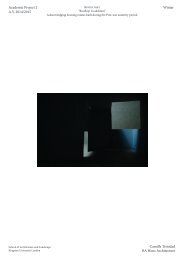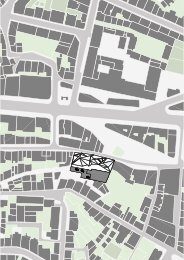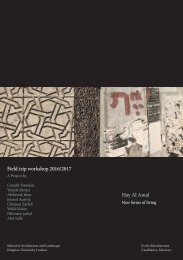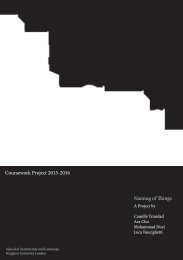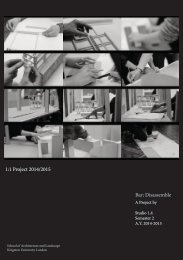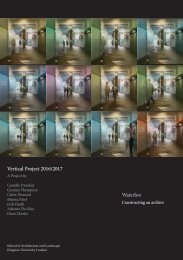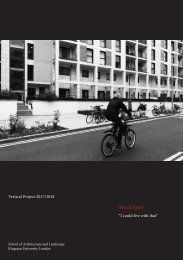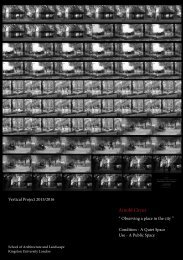National Theatre of the Philippines
My final year dissertation which explored a symbolic edifice in Manila, built by the National Artist for Architecture as per request of the former First Lady of the Philippines. It discusses Architecture's innate role in a political society, specifically in a country that has undergone centuries of colonialism; which got an overall grade of A.
My final year dissertation which explored a symbolic edifice in Manila, built by the National Artist for Architecture as per request of the former First Lady of the Philippines. It discusses Architecture's innate role in a political society, specifically in a country that has undergone centuries of colonialism; which got an overall grade of A.
Create successful ePaper yourself
Turn your PDF publications into a flip-book with our unique Google optimized e-Paper software.
fig. 2.5 Front Elevation 1:500<br />
Elevation<br />
The façade is a two-storey massive heavy rectangular travertine block, which houses <strong>the</strong><br />
auditorium. It sits on an <strong>of</strong>fset podium that continues to flow on its raised curvilinear<br />
ramp that extends throughout <strong>the</strong> perimeter <strong>of</strong> <strong>the</strong> octagonal pool. Deep concave<br />
cantilevers – arched beams that continue upwards support <strong>the</strong> monumental heavy<br />
massing block. Looking across <strong>the</strong> section, <strong>the</strong>re is an illusion <strong>of</strong> sweeping concrete<br />
vaults rotated horizontally across <strong>the</strong> entrance. They act as a primary structure <strong>of</strong> <strong>the</strong><br />
podium on all three sides. The block suspends 12 meters over <strong>the</strong> terrace <strong>of</strong> <strong>the</strong> lobby. It<br />
appears to be floating above <strong>the</strong> podium that is perceived as <strong>the</strong> base <strong>of</strong> <strong>the</strong> building;<br />
which on a distance, seem like it is rooted to <strong>the</strong> ground. The arching ramp is said to be<br />
Manila’s answer to Niemeyer’s Brasilia. The raised element was a response to <strong>the</strong> high<br />
sea levels on <strong>the</strong> reclaimed land but hence critically objectified by <strong>the</strong> society as an<br />
elitist view <strong>of</strong> <strong>the</strong> art culture.<br />
29<br />
The front elevation <strong>of</strong> <strong>the</strong> building gives a picturesque reflection on <strong>the</strong> pool during<br />
daytime as if it is a piece <strong>of</strong> sculpture behind <strong>the</strong> clear blue sky. By night, <strong>the</strong> view <strong>of</strong><br />
<strong>the</strong> façade changes with <strong>the</strong> fountain that jets out water as high as 30 meters, which<br />
resembles a miniature Las Vegas fountain show as underwater lights illuminate <strong>the</strong> pool.<br />
29 AD Classics: Parish Of The Holy Sacrifice / Leandro V. Locsin", Archdaily, 2016 http://www.archdaily.com/790290/ad-classics-parish-<strong>of</strong>-<strong>the</strong>-holy-sacrifice-leandro-v-locsin (accessed 25 September<br />
2017)<br />
!22




